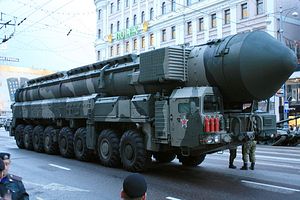Yesterday, Russian President Vladimir Putin announced that Russia will increase its nuclear weapons arsenal in a response to NATO’s alleged conventional military buildup in Europe amidst growing tensions over Ukraine.
The Washington Post quotes from speech that Vladimir Putin delivered to inaugurate “Russia’s military Disneyland” – a high-tech military exposition outside Moscow – in which he stated that his country will add 40 new intercontinental ballistic missiles (ICBMs) to its nuclear arsenal “capable of overcoming any, even the most technically sophisticated, missile defense systems.”
While Putin’s statement yesterday is indeed worrying, it nevertheless appears to reduce the number of new missiles when comparing his remarks to a previous announcement he made six months ago, where he stated that Russia’s Strategic Rocket Forces will receive 50 new ICBMs in 2015.
The new weapons will in all likelihood be RS-24 Yars (SS-27) rockets, Russia’s newest operational fifth-generation intercontinental ballistic missile (ICBM), which can carry multiple independently targetable nuclear warheads and was first introduced into service in July 2010. The RS-24 ICBM together with the single-warhead RS-12M2 ICBM (Topol-M missile system) will be the mainstay of Moscow’s future Strategic Missile Forces (RSMF) main attack force.
As I noted in a piece for the June issue of The Diplomat Magazine, Russia is in the middle of modernizing its strategic and nonstrategic nuclear warheads. According to the Bulletin of the Atomic Scientists, Moscow has currently 4,500 nuclear warheads, of which roughly 1,780 strategic warheads are deployed on missiles and at bomber bases. An additional 700 strategic warheads are kept in storage along with approximately 2,000 nonstrategic warheads. “Russia deploys an estimated 311 ICBMs that can carry approximately 1,050 warheads,” the Bulletin of the Atomic Scientists further notes.
The publication also points out:
There are many uncertainties about the status and future of Russia’s nuclear arsenal. One is poor transparency, due to New START having discontinued public release of detailed aggregate numbers and the fact that Moscow does not publish comprehensive information about its nuclear forces. The increasing diversity of the Russian intercontinental ballistic missile (ICBM) force creates additional uncertainty.
In 2010, President Vladimir Putin announced a massive 20 trillion rubles military modernization project aimed to replace 70 percent of Soviet-era military hardware by 2020, including 50 new warships for the navy, hundreds of new fighter jets, thousands of new vehicles for the ground forces, and the complete modernization of Russia’s strategic nuclear forces.
According to the Bulletin of Atomic Scientists:
In February 2012, then-Prime Minister (now President) Vladimir Putin stated that the military would receive more than 400 advanced ground and sea-based intercontinental ballistic missiles over the coming decade, or an average of 40 missiles per year.
These numbers , however, could be difficult to sustain, least of all because of the financial costs involved as the New York Times points out:
Russia, given its economic problems, probably cannot afford even the weapons that Mr. Putin has pledged to deliver by 2020. Six months ago, he said the country would add 50 ballistic missiles to its nuclear arsenal this year, and at least one senior Russian military official has indicated publicly that the Kremlin’s appetite exceeds its wallet.
I also wrote about Russia’s difficulties in maintaining the current pace of military modernization, given the country’s current economic reality (see: “Is the World’s Deadliest Tank Bankrupting Russia”):
Russia cannot afford military expenditures at such scale in the long-run (…) The only way for Russia to currently finance its growing military expenditure is to tap into the country’s reserve fund – money the Kremlin put aside over the last few years when oil prices were high and meant to cushion the economy against shocks (…). Yet, this calculation may perhaps be too optimistic (…).
According to a Russian-born scholar: “Russia has already spent more than half of its total military budget for 2015. At this rate, its reserve fund will be emptied before the end of the year.”
However, Russia is indeed in the process of retiring all Soviet-era ICBMs and replacing them with new weapon systems, a project that is about halfway complete, according to Western estimates. The estimated completion date for the replacement of all Soviet legacy systems remains 2022.

































